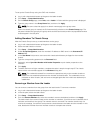
The config subcommand loads the information into other CMCs. The Server Administrator uses the
config command to synchronize the user and password database.
Creating a CMC Configuration File
The CMC configuration file, <filename>.cfg, is used with the racadm config -f <filename>.cfg
command to create a simple text file. The command allows you to build a configuration file (similar to
a .ini file) and configure the CMC from this file.
You may use any file name, and the file does not require a .cfg extension (although it is referred to by that
designation in this subsection).
NOTE: For more information about the getconfig subcommand, see the Chassis Management
Controller for PowerEdge VRTX RACADM Command Line Reference Guide
.
RACADM parses the .cfg file when it is first loaded on to the CMC to verify that a valid group and object
names are present, and that simple syntax rules are being followed. Errors are flagged with the line
number that detected the error, and a message explains the problem. The entire file is parsed for
correctness, and all errors display. If an error is found in the .cfg file, write commands are not transmitted
to the CMC. You must correct all errors before any configuration can take place.
To check for errors before you create the configuration file, use the -c option with the config
subcommand. With the -c option, config only verifies syntax and does not write to the CMC.
Follow these guidelines when you create a .cfg file:
• If the parser encounters an indexed group, it is the value of the anchored object that differentiates the
various indexes.
The parser reads in all of the indexes from the CMC for that group. Any objects within that group are
modifications when the CMC is configured. If a modified object represents a new index, the index is
created on the CMC during configuration.
• You cannot specify a desired index in a .cfg file.
Indexes may be created and deleted. Over time, the group may become fragmented with used and
unused indexes. If an index is present, it is modified. If an index is not present, the first available index
is used.
This method allows flexibility when adding indexed entries where you do not need to make exact
index matches between all the CMCs being managed. New users are added to the first available index.
A .cfg file that parses and runs correctly on one CMC may not run correctly on another, if all indexes
are full and you must add a new user.
• Use the racresetcfg subcommand to configure both the CMCs with identical properties.
Use the racresetcfg subcommand to reset the CMC to original defaults, and then run the racadm
config -f <filename>.cfg
command. Make sure that the .cfg file includes all desired objects,
users, indexes, and other parameters. For a complete list of objects and groups, see the Chassis
Management Controller for PowerEdge VRTX RACADM Command Line Reference Guide.
CAUTION: Use the racresetcfg subcommand to reset the database and the CMC Network
Interface settings to the original default settings and remove all users and user configurations.
While the root user is available, other users’ settings are also reset to the default settings.
94


















